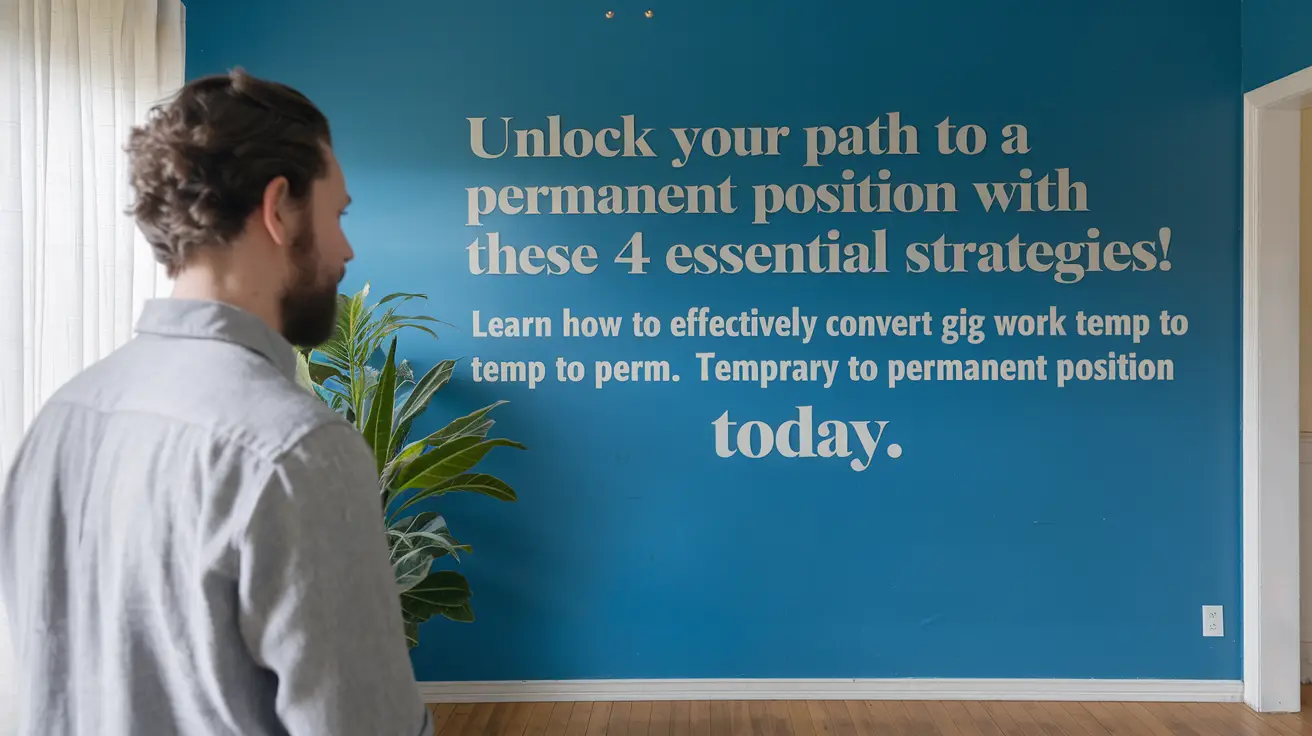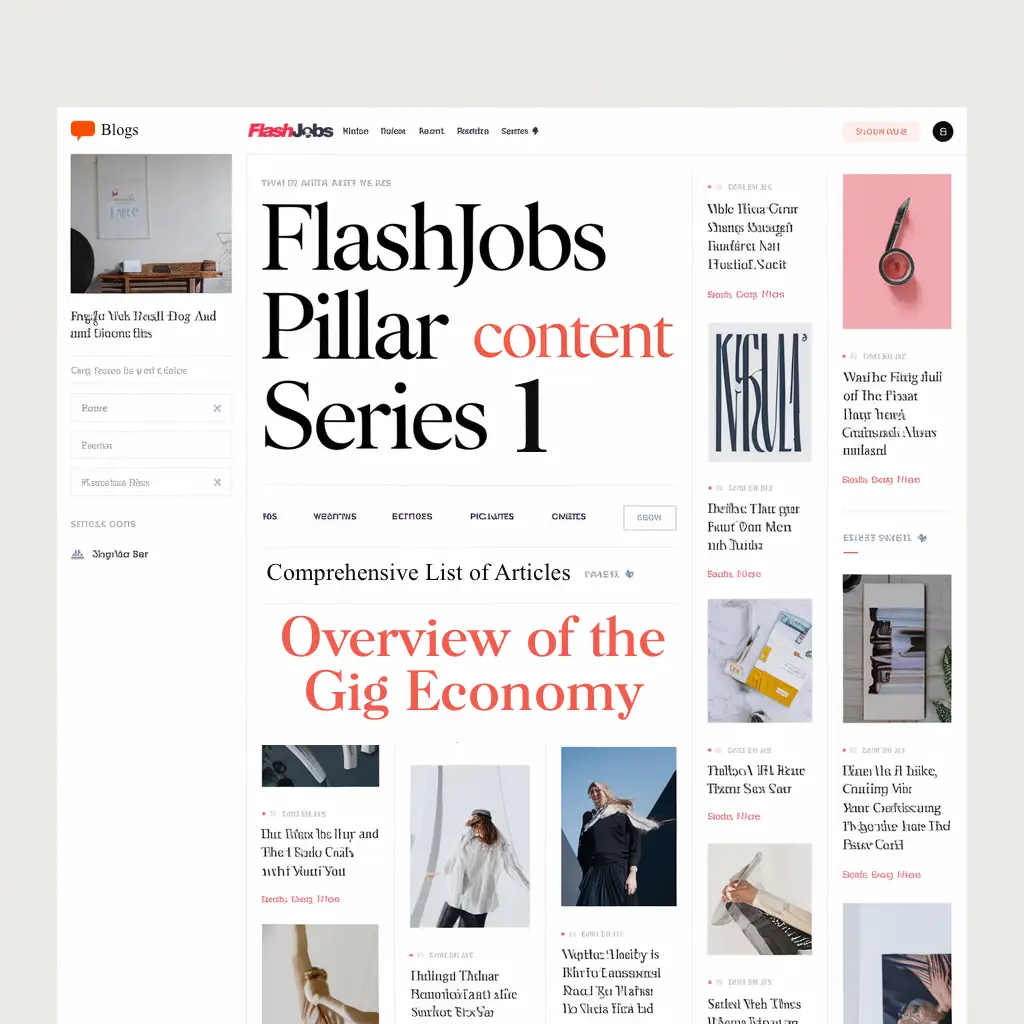Table of Contents
Convert Gig Work Temp to Perm: 4 Strategies for Securing a Full-Time Position
We will delve deeper into the 4 strategies to convert gig work temp to perm, temporary to permanent position. The gig economy has transformed the modern workforce, offering both workers and employers flexibility and opportunities. Many individuals start in temporary positions but aspire to transition into permanent roles. This shift from temporary to permanent employment can be a strategic career move, providing stability and long-term benefits.
Some readers may question why this article uses “gig work” and “temporary positions” interchangeably since these traditionally represented different work arrangements. In the past, company temporary / temp staff had clearer pathways to permanent positions, while gig workers, freelancers, and independent contractors typically remained external to companies without opportunities for permanent employment.
However, the modern workplace has evolved significantly. Staffing agencies and digital platforms now frequently place the same gig workers with the same companies repeatedly, creating longer-term relationships that mirror traditional temporary work arrangements. Companies have begun to recognize the value of these consistent gig workers, treating them similarly to temporary staff and considering them for permanent positions. This shift in employer mindset has effectively blurred the traditional boundaries between gig work and temporary employment, opening new pathways to permanent roles for both groups. Now that I have put this in context, let’s continue with the main topic.
Turning a temporary position into permanent requires exceptional performance, professional behavior, and effective communication with employers. Treating a temporary role as a learning opportunity allows job seekers to understand the company culture and demonstrate their value. By consistently delivering high-quality work and showcasing their skills, temporary workers increase their chances of being considered for permanent positions.
Proactive communication is crucial in this transition. Expressing interest in a permanent role to coworkers and hiring managers can open doors to new opportunities. Job seekers should be prepared to discuss their contributions and how they align with the company’s long-term goals. This approach positions them as valuable assets, increasing the likelihood of a successful temp-to-perm conversion.
Key Takeaways
- Exceptional performance and professional behavior are crucial for transitioning from temporary to permanent roles
- Proactive communication with employers increases chances of securing a permanent position
- Understanding company culture and aligning with organizational goals enhances job seekers’ value to employers
- The 4 Strategies to focus:
- Professional Behavior
- Performance Excellence
- Negotiation Phase
- Professional Development Path

Professional Behavior: Transitioning from Temporary Employment to Permanent Position – A Guide for Employers and Employees
Exemplary conduct and performance are crucial for temporary workers who aim to secure permanent positions. Excelling in key areas can significantly increase the chances of transitioning from a gig role to full-time employment.
Performance Metrics for Temporary Workers
Temporary workers should focus on measurable outcomes to showcase their value. Meeting or exceeding productivity targets is essential. Tracking and documenting completed tasks, projects finished ahead of schedule, and cost-saving initiatives can provide concrete evidence of contributions.
Quality of work is equally important. Maintaining high standards and attention to detail demonstrates professionalism. Reliability and consistency are key performance indicators that employers value in temporary staff.
Adaptability is another critical metric. The ability to quickly learn new systems, processes, and company culture shows versatility and potential for long-term fit.
Demonstrating Value During Temporary Period
Gig workers should proactively seek opportunities to add value beyond their assigned tasks. Volunteering for additional responsibilities or proposing innovative solutions to workplace challenges can set them apart.
Developing a deep understanding of the company’s goals and aligning personal efforts with these objectives demonstrates commitment. Temporary workers should showcase unique skills, such as specialized technical abilities or language proficiency, that can benefit the organization long-term.
Building positive relationships with colleagues and supervisors is crucial. Being a team player and maintaining a constructive attitude, even in challenging situations, leaves a lasting impression.
Professional Behaviors to Stand Out in Gig Work
Punctuality and attendance are fundamental professional behaviors. Consistently arriving on time and maintaining a reliable presence reinforces dependability.
Effective communication skills are vital. Temporary workers should articulate ideas clearly, listen actively, and respond promptly to inquiries. Regular updates on project progress keep supervisors informed and demonstrate initiative.
Maintaining a professional appearance and adhering to company dress codes shows respect for the workplace. When invited, participation in company events and team-building activities displays engagement and interest in the organization’s culture.
Expressing interest in permanent opportunities to supervisors or HR representatives in a professional manner can open doors for future considerations.
Performance Excellence: Converting a Temporary Position to Permanent Employment through Exceptional Work and Professional Growth
Demonstrating exceptional performance is crucial for turning a temporary position into a permanent one. Consistently delivering high-quality work and going above and beyond expectations can significantly increase the chances of securing a long-term role.
Approaching Supervisor about Permanent Role
Timing and approach are key when discussing a permanent position with a supervisor. Schedule a meeting during a less busy period to have an open conversation. Come prepared with specific examples of contributions and achievements. Express genuine interest in the company’s long-term goals and how you can contribute.
Be professional and confident, but avoid appearing entitled. Frame the discussion around mutual benefits – how a permanent role would allow you to add more value to the organization. Listen carefully to feedback and be open to suggestions for improvement.
Best Time to Request Permanent Position
The optimal time to request a permanent position varies depending on the company and role. Generally, wait until you’ve been in the temporary role for at least 3-4 months. This allows sufficient time to prove your value and understand the organization.
Consider the company’s current needs and growth plans. If they’re expanding or a permanent position opens up, that’s an ideal opportunity. Pay attention to positive feedback from colleagues and hiring managers. Strong performance reviews can provide leverage for your request.
Avoid asking during high-stress periods or immediately after making mistakes. Choose a time when your recent accomplishments are fresh in your supervisor’s mind.
Showcasing Long-Term Commitment to the Company
Demonstrating commitment goes beyond daily tasks. Take initiative on long-term projects that benefit the company. Volunteer for additional responsibilities that showcase your versatility and willingness to grow with the organization.
Invest in learning about the company’s industry, goals, and challenges. Treat your temporary role as a learning opportunity. Share innovative ideas that align with the company’s objectives. This will show that you think beyond your current position.
Build strong relationships with colleagues across departments. Participate in company events and initiatives. This integration demonstrates you’re invested in the company culture and see yourself as part of its future.
Negotiation Phase: Transitioning from Temporary to Permanent Employment – Strategic Discussions Between Employer and Employee
The negotiation phase is crucial when transitioning from a temporary to a permanent position. It involves discussing salary, benefits, and presenting a compelling case for fair compensation.
Considering Salary and Benefits for Transition
When moving from a temp to perm role, carefully evaluate the entire compensation package. Temp-to-perm employment often comes with additional benefits not available to temporary workers. These may include health insurance, retirement plans, and paid time off.
Compare the hourly rate as a temp to the proposed annual salary. Factor in the value of benefits to determine if the offer is competitive. Research industry standards for similar permanent positions to gauge fair compensation.
Consider long-term career growth opportunities. A lower initial salary might be acceptable if there’s potential for advancement within the company.
Negotiating Fair Compensation for Permanent Role
Armed with data on market rates, approach salary negotiations with confidence. Highlight specific achievements and the value brought to the company during the temporary period. Quantify contributions, such as cost savings or productivity improvements, where possible.
Be prepared to discuss why a higher salary is justified. Focus on skills, experience, and proven performance in the role. Emphasize how permanent status will allow for even greater contributions to the organization.
Consider negotiating for performance-based bonuses or salary reviews after a set period. This shows commitment to excellence and aligns personal success with company goals.
Including Key Points in Counter Offer Letter
When crafting a counteroffer letter, maintain a professional and appreciative tone. Begin by expressing enthusiasm for the permanent opportunity and gratitude for the initial offer.
Clearly state the desired salary and benefits package. Provide brief justification for the request, referencing market data and personal qualifications. Include a bulleted list of key accomplishments during the temporary period to support the case.
• Increased department efficiency by 15% • Implemented a new process saving $10,000 annually • Received excellent feedback from clients and colleagues
Close the letter by reaffirming interest in the role and willingness to discuss further. Keep the tone positive and focused on mutual benefit for both parties.
Professional Development Path: From Temporary Employee to Permanent Position – Building Your Career Through Contract-to-Hire Opportunities
Advancing your career from a temporary role to a permanent position requires strategic planning and continuous growth. Focus on enhancing your skills, building relationships, and demonstrating your value to increase your chances of securing long-term employment.
Continuing Professional Development Post Temporary Role
Temporary workers should prioritize ongoing learning to remain competitive in the job market. Take advantage of online courses, workshops, and industry certifications to expand your skillset. Stay updated on industry trends and best practices through professional publications and webinars.
Consider pursuing relevant qualifications that align with your career goals. This demonstrates initiative and commitment to potential employers. Seek feedback from supervisors and colleagues to identify areas for improvement.
Create a personal development plan outlining short-term and long-term objectives. Set realistic milestones and track your progress regularly. Actively seek opportunities to apply new skills within your current role to showcase your growth.
Strategies to Stay Connected with the Company
Building strong relationships is crucial for turning a temporary position into a permanent opportunity. Engage with team members and supervisors beyond work-related tasks. Attend company events and social gatherings when possible to integrate into the company culture.
Communicate regularly with your manager about your performance and interest in permanent employment. Schedule periodic check-ins to discuss your progress and potential opportunities within the organization.
Network with colleagues from different departments to broaden your understanding of the company. This can lead to valuable connections and insider knowledge about upcoming permanent positions.
Volunteer for additional responsibilities or cross-departmental projects to increase your visibility and demonstrate your commitment to the organization’s success.
Leveraging Temporary Experience for Permanent Gig Role
Use your temporary role as a platform to showcase your skills and work ethic. Consistently deliver high-quality work and meet deadlines to establish a reputation for excellence. Go above and beyond your assigned duties when appropriate.
Document your achievements and contributions during your temporary assignment. Record projects completed, challenges overcome, and positive feedback received. This information can be valuable when discussing a potential permanent position.
Adapt quickly to the company’s work environment and culture. Demonstrate your ability to collaborate effectively with team members and contribute to a positive workplace atmosphere.
Seek opportunities to add value beyond your job description. Propose innovative solutions to existing problems or suggest process improvements to show your long-term potential as a permanent employee.
Conclusion: Convert Gig Work Temp to Perm Temporary to Permanent Position as a Success
The journey from a gig worker or temporary employee to a permanent position requires a strategic blend of excellence, professional behavior, and calculated negotiation. As the lines between gig work and temporary employment continue to blur through staffing agencies and digital platforms, more companies are recognizing the potential of converting consistent gig workers into permanent employees. Job seekers in the gig economy must treat their temporary role as a stepping stone, demonstrating exceptional performance while expressing genuine interest in permanent opportunities. Converting a temporary position into a permanent one demands consistent dedication, whether through direct requests for consideration or by proving oneself as an invaluable team member worthy of a full-time position.
Success in transitioning from temporary to permanent employment hinges on the worker’s ability to navigate the development path while maintaining professional excellence throughout the temporary period. When offered a permanent role, temp workers should confidently approach the negotiation phase, backed by their demonstrated achievements and contributions. This evolution in workplace dynamics has created new opportunities for both traditional temp staff and gig workers alike to secure permanent positions, provided they effectively showcase their value, maintain strong professional relationships, and strategically position themselves as the right candidate for permanent employment within the organization.





